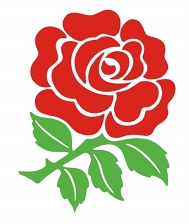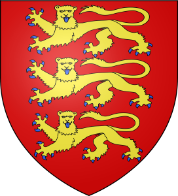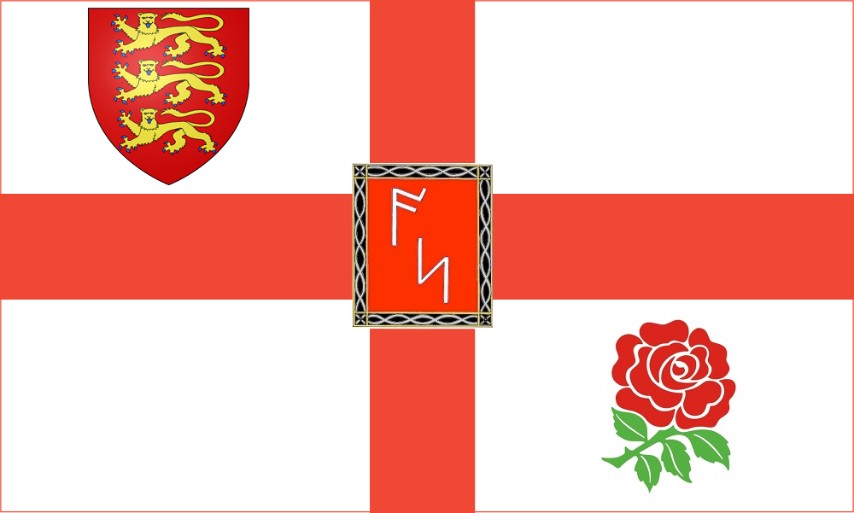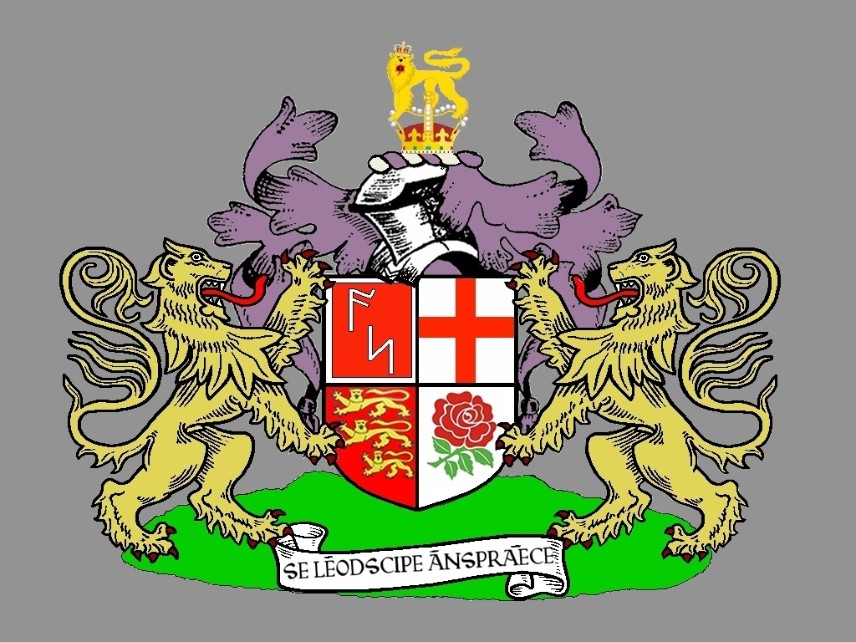A New English Flag.
Background.
The celebration of St George's Day is currently fairly low key in England and much more celebrated elsewhere. However, the Society and its members are clearly succeeding in their constant efforts to revive St. George's Day as the day on which to celebrate being English
There are many legends in many cultures about St. George, but they all have a common theme; he must have been an outstanding character in his lifetime, for his reputation to have survived for almost 1,700 years!
Most authorities on the subject seem to agree that he was born in Cappadocia in what is now Turkey, in about the year 280 AD. It is probable that from his physical description, he was of Darian origin, because of his tall stature and fair hair. He enlisted into the Cavalry of the Roman Army at the age of 17, during the reign of the Emperor Diocletian and very quickly established a reputation amongst his peers, for his virtuous behaviour and physical strength; his military bearing, valour and handsome good looks.
He quickly achieved the rank of Millenary or Tribunus Militum, an officer's rank roughly equivalent to a full Colonel, in charge of a regiment of 1,000 men and became a particular favourite of his Emperor. Diocletian was a skilled military tactician and strict disciplinarian, who set himself the task of rejuvenating the morale of the citizens of Rome by reviving the prevailing traditions and paganism of Rome. It may be recalled that this was a time of high inflation and civil unrest and one outcome of this was the increasing influence of Christianity.
Diocletian's second in Command was Galerius, the conqueror of Persia and an avid supporter of the Pagan religion. As a result of a rumour that the Christians were plotting the death of Galerius, an edict was issued that all Christian Churches were to be destroyed and all scriptures to be burnt. Anyone admitting to being a Christian, would lose his rights as a citizen, if not his life
As a consequence, Diocletian took strict action against any alternative forms of religion in general and the Christian faith in particular. He achieved the reputation of being perhaps the cruellest persecutor of Christians at that time.
Many Christians feared to be loyal to their God; but, having become a convert to Christianity, St. George acted to limit the excesses of Diocletian's actions against the Christians. He went to the city of Nicomedia where, upon entering, he tore down the notice of the Emperor's edict. St. George gained great respect for his compassion towards Diocletian's victims.
As news spread of his rebellion against the persecutions St. George realised that, as both Diocletian and Galerius were in the city, it would not be long before he was arrested.He prepared for the event by disposing of his property to the poor and he freed his slaves.
When he appeared before Diocietian, it is said that St. George bravely denounced him for his unnecessary cruelty and injustice and that he made an eloquent and courageous speech. He stirred the populace with his powerful and convincing rhetoric against the Imperial Decree to persecute Christians. Diocietian refused to acknowledge or accede to St. George's reasoned, reproachful condemnation of his actions. The Emperor consigned St George to prison with instructions that he be tortured until he denied his faith in Christ
St George, having defended his faith was beheaded at Nicomedia near Lyddia in Palestine on the 23rd of April in the year 303 AD.
Extract from text at :http://www.royalsocietyofstgeorge.com/stgeorge.htm
The Origin of the Flag.
The Romanesque Monastic order in Prague established St. George's Church in the Castle in the year 920AD and in the year 1119 AD the Cathedral of St George was founded in Novgorod. His reputation for virtue and chivalrous conduct became the spiritual inspiration of the Crusaders and by this time the pennant or flag with a red cross on a white or silver background became prominent as a means of recognition by English Knights. It was also worn on breast plates.
In the year 1348 King Edward III established the Knights of the Garter, which is the oldest order of Chivalry in Europe. The Order of the Garter was dedicated to the Blessed Virgin Mary, Edward the Confessor and St George. The Insignia of the order consists of a collar and badge appendant known as the George, the Star, the Garter and the Sash with the Investment Badge called the lesser George. This is a gold and richly enamelled representation of St George on horseback slaying the dragon.
A similar representation of St George can be seen in our Armorial Bearings and in the collar and appendant that officers of The Royal Society wear.
In 1352 the College of St George was established in Windsor, with 6 Chorister boys and since then, St George's school has played an important role in the daily worship and on State Occasions in the Queen's Free Chapel of St George in Windsor Castle. By providing free education and sustenance for the boys, a priceless musical inheritance in choral worship has been established and their numbers increased until the Plague struck in 1479 when the numbers were reduced from thirteen to six again but recovered to thirteen by Michaelmas in 1482.
It was in the year 1415 AD that St. George became the Patron Saint of England when English Soldiers under Henry V won the battle of Agincourt.
In 1497 in the reign of Henry VIII, the pennant of the Cross of St. George was flown by John Cabot when he sailed to Newfoundland and it was also flown by Sir Francis Drake and Sir Walter Raleigh. In 1620 it was the flag that was flown by the Mayflower when the Pilgrim Fathers arrived in Plymouth Massachusetts. It is also the flag of the Church of England and as such is known throughout Christendom.
During World War 2 King George VI established the George Cross for outstanding acts of Civilian Valour and one of the earliest recipients was the Island of Malta, for its outstanding courage in the face of the constant bombardment by the Italian and German Airforce. It is, coincidentally, the Island that was so closely associated and governed by the Crusaders who arrived from the Island of Rhodes in the 14th Century, following their 200 year war with the Turks.
Extract from text at :http://www.royalsocietyofstgeorge.com/stgeorge.htm
The original Flag.

New Elements on an old flag.
It is my intention to propose a new England Flag for England and the English people, as the original England flag, good though it is, is not unique to England. As has been seen in the above paragraphs, the St. George's cross was used by many others before coming to England. The international convention is that a nation's flag should be unique to that nation, so how come England has to be left out? I therefore suggest that two elements be added to the St. George's Flag, to make it a proper England Flag.
Richard I.
The Lions on a
shield were the emblem of Richard I, and the three golden lions on a red
shield, were the final version used by Richard I during and after the
third Crusades, up until his death in France in 1199. The Three lions on
a red shield have been the royal badge of England ever since.
The English Rose.
The war of the roses began in May 1455, with the first battle at St. Albans. The last armed engagement was at Stokes, in 1487; just over thirty years of grievances between two families, played out in various corners of England.
As for the roses themselves, the White Rose of York and the Red Rose of Lancaster were fixed in the public's mind by Shakespeare. They were referred to in his play "Henry VI". There is no historical reference to the romantic idea that the Yorks and the Lancasters plucked their roses as a sign of loyalty to their respective families while conversing in a garden.
From an Article by "Tudor Rose"
From the website : http://www.aboutbritain.com/articles/war-of-the-roses-page1.asp
An Anglo-Saxon Badge.
The Anglo-Saxon Badge was created by the English Constitution author on 23rd December 2010 as a way of representing the Anglo-Saxons that came to Britannia in the middle of the fifth century and from then on created England and the then new English people. It is formed of a red square with an Anglo-Saxon style border, in gold and silver with a black background, with the Anglo-Saxon runes A and S in the center, meaning Anglo-Saxon. It is a very simple design meant to be used as a badge for a jacket, or jewellery, or as in this case on the proposed new England Flag to represent the modern England and the English people, subject to the nation's approval.
The English Rose.  | My Anglo-Saxon Badge.  (C) Mark Higginson 2010. |
King Richard I, Coat of Arms.

A New English Flag.
It is my proposal to the viewer(s) of this website that in order to make the flag unique to England and the English people, and that no one else can have claim to it, that the above two elements be added.
In the upper left quadrant is placed the badge that I created to represent the Anglo-Saxons, the first English people to create and populate England. The second element, the English Rose, that represents the civil war that determined the course of English History not only for the monarchy, but also the English people, is set in the lower right quadrant. These two elements plus the St. George's red cross on a white background, with which they are set, represents the potted history, if you will, of England and the English people, and is unique to us and no one else.

Conclusion.
This is nothing but a proposal, and cannot happen without the will of the people of England. However, if we are to claim to have an identity that no one can brush to one side, then we must be prepared to make a stand on that claim. A people are recognized as a people by several things, language, the land they come from, the money they use, their measuring systems, the way they dress, their national anthem and their country's flag. If we are to prove ourselves a distinct people, not just 'BRITISH', but English, then we have to make it happen, no one else will. This website, including this proposal for a new flag, is geared to that end. The establishment and maintenance of the unique identity that is English, the Modern Anglo-Saxon English.
Something New.
Here is the Coat of Arms for England, designed by me, perhaps you will like it.

Here's a little riddle. Look at the motto and tell me what you think it says in modern Queens English.
I'll let you know if your right.